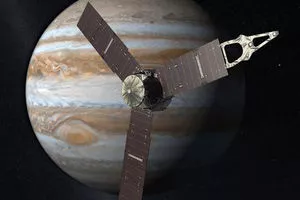View Other Topics.
 Jul 3, 2016
Jul 3, 2016
According to space.com, tomorrow, July 4, 2016, a U.S. spacecraft named Juno, will rendezvous with Jupiter, the largest planet in our Solar System.
Juno was launched on an Atlas 5 rocket Aug. 5, 2011, at 12:25 pm EDT. It is scheduled to slide into orbit around the solar system's largest planet tomorrow on July 4, 2016 at 8:35 p.m. PDT/11:35 p.m. EDT (Earth Received Time).. The probe will then study Jupiter for at least a year, mapping out the gas giant's magnetic and gravity fields, characterizing the planet's thick atmosphere and performing other science work over the course of dozens of orbits.
Juno has been traveling at a velocity of approximately 60,000 miles per hour (about 26.9 kilometers per second) relative to Earth, 15,000 miles per hour (about 6.7 kilometers per second) relative to the Sun, and 13,000 miles per hour (about 6 kilometers per second) relative to Jupiter. Juno has now travelled 1.74 billion miles (2.8 billion kilometers, or 18.73 AU) since launch.
On March 8th, 2016, Jupiter and Earth are closest, at 413 million miles, which happens every 13 months. In July, the Juno probe will enter Jovian orbit, skimming just 3100 miles from the cloud tops. Repeated passes should give researchers a good idea of the planet’s composition, which likely includes ha vast reserve of hydrogen compressed to the metallic state surrounding a rocket ice core.
The NASA probe, that will study how the Gas Giant formed, will use a gravity-assist from Earth on October 9th, 2013 to gain the necessary momentum to reach its destination
Track and visualize Juno’s journey through space using NASA's Eyes on the Solar System 3D interactive.
Juno’s onboard color camera, called JunoCam, invites the public to serve as a virtual imaging team. Vote and comment on where to point JunoCam and which features to image on Jupiter using the new JunoCam web platform on this site.
NASA posted its first message to its new Tumblr page adding that platform to its large collection of social media accounts on Facebook, YouTube, Twitter and Instagram. And echoing its Twitter strategy, where a separate account can be found for nearly every individual mission, department and group of interest (around 140 at last count, not including individual astronauts), NASA is getting specific: opening up not just one but five diverse Tumblr accounts to start.
Image: Artist's illustration of NASA's Juno spacecraft at Jupiter. Credit: NASA/JPL-Caltech
Tags:
#juno,#NASA,#Jupiter,##earth,#astrology,#space,#starzpsychics.com,#starz#advisors
Juno at Jupiter.

According to space.com, tomorrow, July 4, 2016, a U.S. spacecraft named Juno, will rendezvous with Jupiter, the largest planet in our Solar System.
Juno was launched on an Atlas 5 rocket Aug. 5, 2011, at 12:25 pm EDT. It is scheduled to slide into orbit around the solar system's largest planet tomorrow on July 4, 2016 at 8:35 p.m. PDT/11:35 p.m. EDT (Earth Received Time).. The probe will then study Jupiter for at least a year, mapping out the gas giant's magnetic and gravity fields, characterizing the planet's thick atmosphere and performing other science work over the course of dozens of orbits.
Juno has been traveling at a velocity of approximately 60,000 miles per hour (about 26.9 kilometers per second) relative to Earth, 15,000 miles per hour (about 6.7 kilometers per second) relative to the Sun, and 13,000 miles per hour (about 6 kilometers per second) relative to Jupiter. Juno has now travelled 1.74 billion miles (2.8 billion kilometers, or 18.73 AU) since launch.
On March 8th, 2016, Jupiter and Earth are closest, at 413 million miles, which happens every 13 months. In July, the Juno probe will enter Jovian orbit, skimming just 3100 miles from the cloud tops. Repeated passes should give researchers a good idea of the planet’s composition, which likely includes ha vast reserve of hydrogen compressed to the metallic state surrounding a rocket ice core.
The NASA probe, that will study how the Gas Giant formed, will use a gravity-assist from Earth on October 9th, 2013 to gain the necessary momentum to reach its destination
Track and visualize Juno’s journey through space using NASA's Eyes on the Solar System 3D interactive.
Juno’s onboard color camera, called JunoCam, invites the public to serve as a virtual imaging team. Vote and comment on where to point JunoCam and which features to image on Jupiter using the new JunoCam web platform on this site.
NASA posted its first message to its new Tumblr page adding that platform to its large collection of social media accounts on Facebook, YouTube, Twitter and Instagram. And echoing its Twitter strategy, where a separate account can be found for nearly every individual mission, department and group of interest (around 140 at last count, not including individual astronauts), NASA is getting specific: opening up not just one but five diverse Tumblr accounts to start.
Image: Artist's illustration of NASA's Juno spacecraft at Jupiter. Credit: NASA/JPL-Caltech
Share this article with friends!
Tags:
#juno,#NASA,#Jupiter,##earth,#astrology,#space,#starzpsychics.com,#starz#advisors






